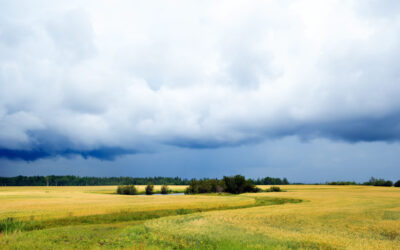ALUS WUQWATR participants Terry and Lynda Mearns enjoy a wildlife haven while retaining water on the landscape, naturally.

Through their ALUS projects, WUQWATR participants Terry and Lynda Mearns are helping to improve water quality for their community, upstream of Last Mountain Lake. Photo: Delee Grant
In 2011, extreme rains caused major flooding near the community of Silton, Saskatchewan, northwest of Regina. For local residents Terry and Lynda Mearns, the water washed out a natural dam on their property, a 160-acre parcel of land located upstream of Last Mountain Lake.
Once the water receded, they knew what they had to do: call their local ALUS program. With ALUS WUQWATR’s help, they not only reconstructed the dam, but also restored their large, 16-acre wetland.

Before and after: In 2011, extreme rains washed out a natural dam on the Mearns’ property. With ALUS WUQWATR’s help, they not only reconstructed the dam, but also restored their 16-acre wetland.
The Mearns’ ALUS project is intended to improve water-storage capacity on their land, and produce many other ecosystem services for the benefit of the community.
To that end, Mearns planted grasses and trees along the shore, which are now being augmented by naturally reestablishing forbs (herbaceous flowering plants).
The deep-rooted, water-tolerant grass species seeded along the dam and adjacent to the shoreline provide bank stabilization which helps to improve water quality. Meanwhile, all of this provides habitat for pollinators.
By restoring this large wetland through ALUS, the Mearns improve both the quality and quantity of the water impacting the downstream communities along Last Mountain Lake. It also allows the Mearns family to enjoy a wildlife haven in their own backyard.

ALUS WUQWTR participants Terry and Lynda Mearns are banking on the ability of the natural landscape, enhanced through ALUS, to retain water during heavy rainfall, and therefore to significantly reduce the risk of damage to neighbouring communities in the future, while also producing many other ecosystem services for the benefit of all.
The Mearns enjoy the time they spend managing and maintaining their restored wetland—one of the reasons is observing all the abundant wildlife it attracts. As avid wildlife enthusiasts, Terry and Lynda build bluebird boxes and install waterfowl henhouses to provide habitat for their avian companions.
“My appreciation of nature started early on through hunting,” says Terry. “Now, with ALUS, I have the chance to give back to nature and wildlife.”
Today, ducks, geese, beavers, white-tail deer and even northern leopard frogs are at home on this ALUS project, while many insects, including bumblebees and countless blue damselflies sailing over the wetland make the picturesque scene quite literally abuzz with activity.
During the 2011 flood, many surrounding communities had to respond swiftly, and at great expense, to construct physical barriers to protect homes and infrastructure. But the Mearns are banking on the ability of the natural landscape, enhanced through ALUS, to retain water during heavy rainfall, and therefore to significantly reduce the risk of damage to neighbouring communities in the future.

“My appreciation of nature started early on through hunting,” says ALUS WUQWATR participant Terry Mearns. “Now, with ALUS, I have the chance to give back to nature and wildlife.” Today, ducks, geese, beavers, white-tail deer and even northern leopard frogs are at home on this ALUS project, while many insects, including bumblebees and countless blue damselflies make the picturesque scene quite literally abuzz with activity. Photo: Delee Grant



